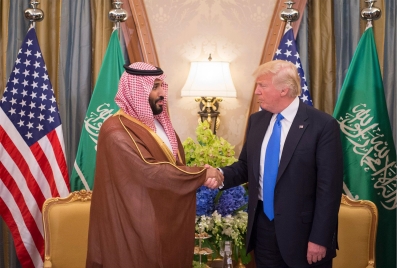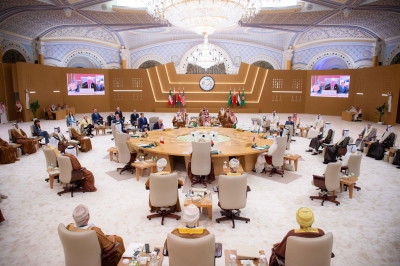

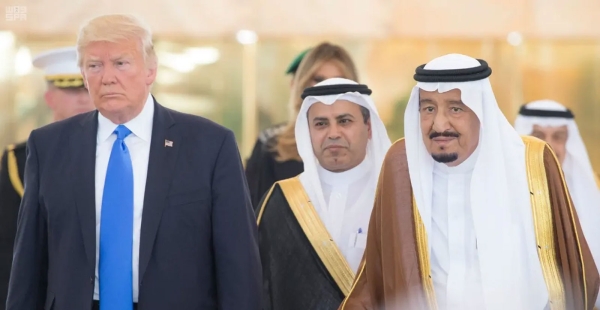
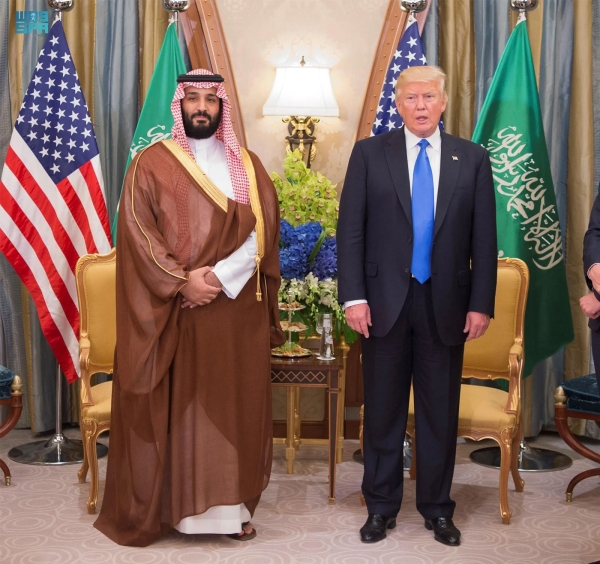
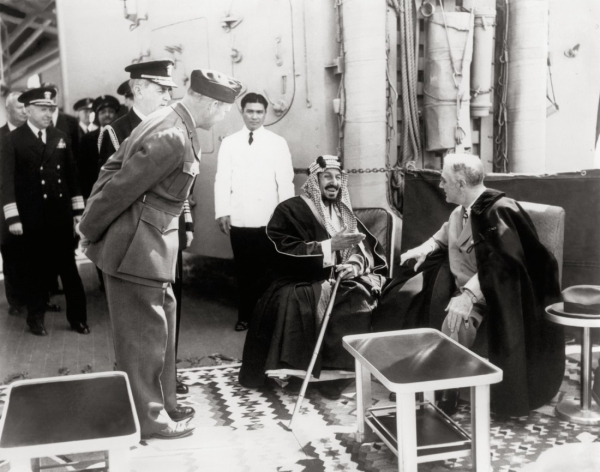
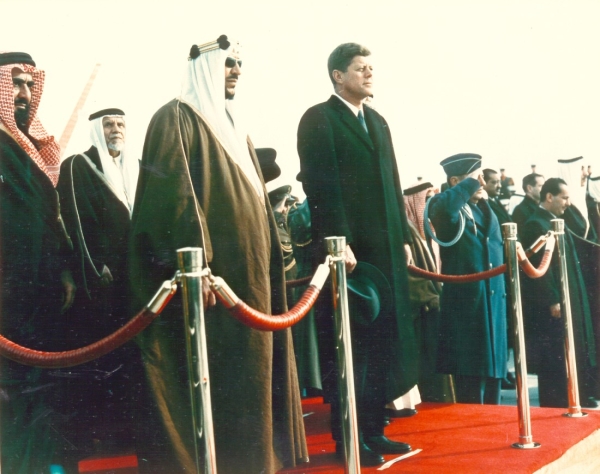
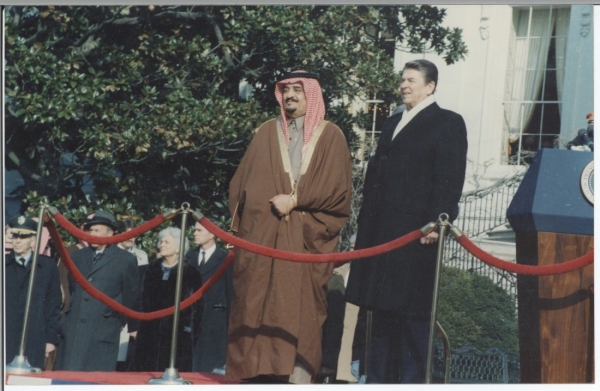
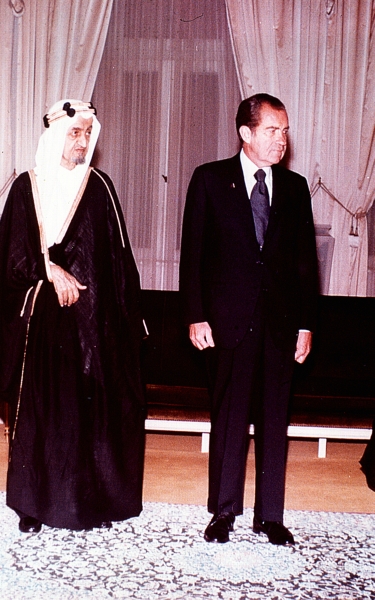
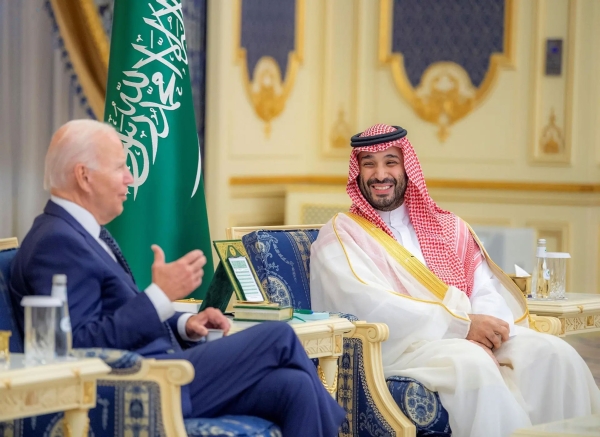

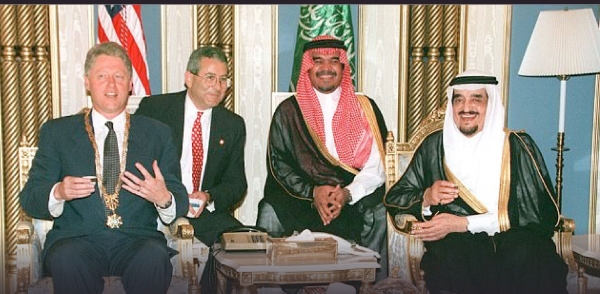
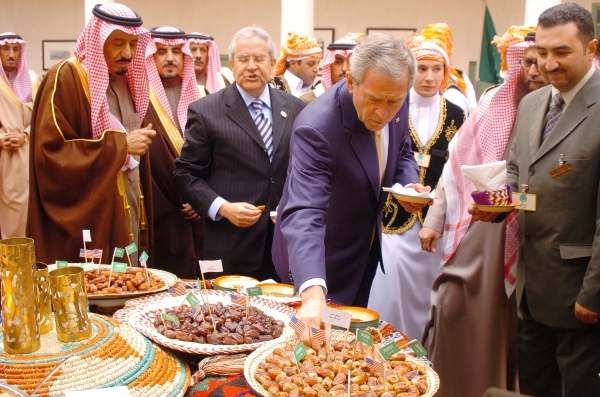

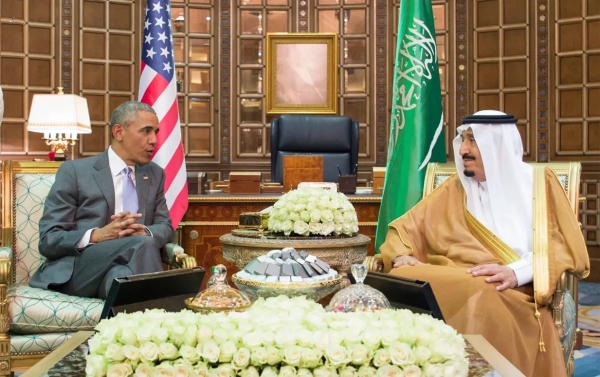
Saudi–U.S. relations refer to the diplomatic relations between the Kingdom of Saudi Arabia and the United States of America, dating back to 1931, when commercial oil exploration and production began in Saudi Arabia. These relations were established in line with Saudi Arabia’s foreign policy approach, which seeks to build relationships that serve national interests and diversify diplomatic connections with all countries based on the principles upheld by Saudi Arabia.
For over nine decades, Saudi-U.S. relations have proven to be strong and well-established, encompassing close coordination on counterterrorism and military operations, as well as economic exchange and investment.
History of Saudi–U.S. Relations
After King Abdulaziz granted an American company the right to explore oil in 1931, a cooperation agreement was signed on November 7, 1933. The historic meeting between King Abdulaziz and the United States' President Franklin D. Roosevelt aboard the USS Quincy on February 14, 1945, laid the foundation for a strategic partnership based on mutual respect and trust.
To celebrate the new friendship between Saudi Arabia and the United States, the two leaders exchanged gifts. Roosevelt gifted King Abdulaziz a DC-3 passenger plane. In the following months, Roosevelt sent two additional planes, leading to the establishment of Saudi Arabia’s national airline, the Saudi Arabian Airlines.
That same year, 1945, an agreement was signed to build the Dhahran Air Base. The agreement initially included a three-year lease period, which was renewed in 1949. It later led to the development of a civil aviation station project (completed in 1955), which was later named Dhahran International Airport. In 1953, the United States and Saudi Arabia signed a Mutual Defense Assistance Agreement.
Saudi Arabia’s leadership role in the Arab and Islamic worlds, along with its strategic location, has contributed to strengthening its bilateral relationship with the United States. This led to maintaining the stability, security, and prosperity of the Gulf and Middle East regions, and continuing consultations on many regional and global issues of vital interest to both countries.
In this context, the efforts of His Royal Highness Crown Prince and Prime Minister Mohammed Bin Salman Bin Abdulaziz Al Saud stand as a testament to advancing Saudi–U.S. friendship. He has worked to deepen and strengthen aspects of cooperation and build strategic partnerships that serve the shared interests of both nations, aligning with Saudi Vision 2030. This complements the political cooperation between the two influential global powers in addressing regional and international developments, based on Saudi Arabia’s positions on various issues.
Official Visits Between Saudi Arabia and the United States
Exchanges of visits and meetings between the leaders and senior officials of both countries have continued since the reign of the founding King Abdulaziz Bin Abdulrahman Al Saud, through the reigns of his sons, King Saud, King Faisal, King Khalid, King Fahd, and King Abdullah, to the era of the Custodian of the Two Holy Mosques King Salman Bin Abdulaziz Al Saud.
The First Visit by a Saudi King to the United States
King Saud Bin Abdulaziz Al Saud visited the United States at the invitation of President Dwight D. Eisenhower on January 29, 1957, becoming the first Saudi king to visit the United States.
In the following years, official visits were exchanged between the two countries, including:
Saudi Visits to the United States
Visit by King Faisal Bin Abdulaziz Al Saud in 1966.
Visit by King Khalid Bin Abdulaziz Al Saud in 1978.
Visit by King Fahd Bin Abdulaziz Al Saud in 1985.
Visit by King Abdullah Bin Abdulaziz Al Saud in 2010.
Visit by King Salman Bin Abdulaziz Al Saud (then Crown Prince) in 2012.
Visit by King Salman Bin Abdulaziz Al Saud in 2015.
Visit by Crown Prince Mohammed Bin Salman Bin Abdulaziz in 2015.
Visit by Crown Prince Mohammed Bin Salman Bin Abdulaziz in 2016.
Visit by Crown Prince Mohammed Bin Salman Bin Abdulaziz in 2017.
Visit by Crown Prince Mohammed Bin Salman Bin Abdulaziz in 2018.
Visit by Crown Prince Mohammed Bin Salman Bin Abdulaziz in 2025.
U.S. Visits to Saudi Arabia
Visit by President Richard Nixon in 1974.
Visit by President Jimmy Carter in 1978.
Visit by President Bill Clinton in 1994.
Visit by President George W. Bush in 2008.
Visit by President Barack Obama in 2009.
Visit by President Barack Obama in 2014.
Visit by President Barack Obama in 2015.
Visit by President Barack Obama in 2016.
Visit by President Donald Trump in 2017.
Visit by President Joseph Biden in 2022.
Visit by President Donald Trump in 2025.
Global Influence of Saudi–U.S. Relations
The world views Saudi–U.S. relations as a fundamental pillar for enhancing the security and economy of the region and the world, given the pivotal roles of both countries in promoting international peace and security. This is due to their political, security, and economic status and their membership in the G20. The United States has welcomed Saudi Arabia’s efforts to combat climate change, particularly the Middle East Green Initiative launched by Crown Prince Mohammed Bin Salman.
Saudi–U.S. Economic Relations
On the economic front, the two countries maintain strong ties. A total of 742 American companies operate in Saudi Arabia across various sectors. The total U.S. capital invested in Saudi Arabia amounts to SAR90.6 billion. There were also 21,034 American trademarks in the Saudi market by 2022.
The United States ranks as Saudi Arabia’s fourth-largest trading partner in total trade volume, second in imports, and sixth in exports. Conversely, Saudi Arabia ranks twenty-eighth as an export partner and thirty-first as an import partner for the United States in 2021.
Trade relations between the United States and Saudi Arabia form the cornerstone of economic engagement between the two countries. In 2023, total bilateral trade exceeded SAR112 billion, with Saudi Arabia’s total exports to the United States amounting to SAR60 billion, including SAR51.5 billion in crude oil. Saudi Arabia remains a key supplier of oil to the United States. In the non-oil sector, Saudi Arabia’s total exports to the United States reached SAR8.5 billion. Fertilizers topped non-oil exports with a value of SAR3 billion, accounting for 35 percent of Saudi Arabia’s non-oil exports to the United States and recording a 2 percent year-on-year growth. Organic chemicals ranked as the second-largest non-oil export category, with a value of SAR2.6 billion, representing 31 percent of total non-oil exports.
In 2024, the volume of U.S. direct investments in Saudi Arabia reached approximately SAR57.3 billion, while the volume of trade exchange between the two countries amounted to around SAR120 billion. Saudi Arabia exported goods and products to the United States worth SAR48.7 billion, while imports from the U.S. totaled SAR71.3 billion.
U.S.–Saudi Business Council
The U.S.–Saudi Business Council was established in 1993 as a nonprofit organization, stemming from the Saudi–U.S. Joint Economic Committee. The council works to promote business between Saudi and American commercial communities. It annually provides information, influence, and assistance to member companies in both countries, as well as to non-member Saudi and American companies, to build successful partnerships through trade missions, business development services, conferences, networking opportunities, and organized publications.
On May 10, 2024, the U.S.–Saudi Business Council held a celebration in Houston, Texas, marking its thirtieth anniversary.
Saudi-U.S. Strategic Economic Partnership
Coinciding with the visit of U.S. President Donald Trump to Saudi Arabia, on May 13, 2025, His Royal Highness Crown Prince and Prime Minister Mohammed Bin Salman Bin Abdulaziz and President of the United States Donald Trump signed the Strategic Economic Partnership Document between the Government of Saudi Arabia and the Government of the United States of America. The Crown Prince and the U.S. President also witnessed the signing and announcement of a number of bilateral agreements and cooperation memorandums.
Saudi–U.S. Investment Forum
On May 13, 2025, Riyadh hosted the Saudi–U.S. Investment Forum as a platform to enhance economic cooperation between the two nations. The forum explored new investment prospects in vital sectors. It was held at the King Abdulaziz International Conference Center, bringing together financial and business leaders from both sides, with around two thousand participants and 125 speakers across fifteen sessions.
Saudi–U.S. Cultural and Educational Relations
Saudi Arabia and the United States enjoy cultural and educational ties. In 2025, the number of Saudi students studying in the United States under the Custodian of the Two Holy Mosques Scholarship Program reached 14,845. Since the program’s launch in 2006, more than half a million Saudi students have studied in the United States. Saudi Arabia's government has granted 318 scholarships to students from the United States, and there are 289 agreements, memorandums of cooperation, executive programs, and service contracts between Saudi and American universities.
Related quizzes
Related articles
